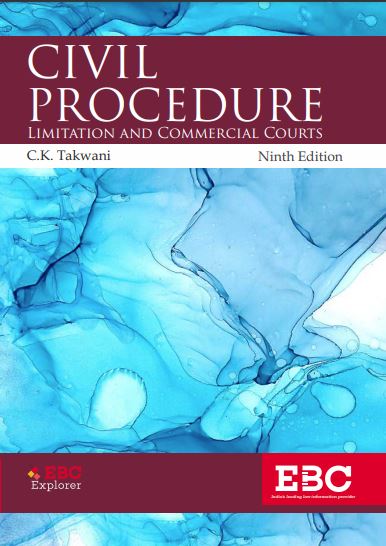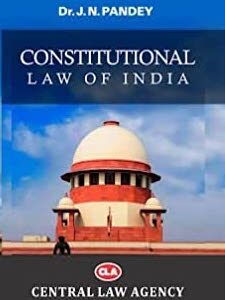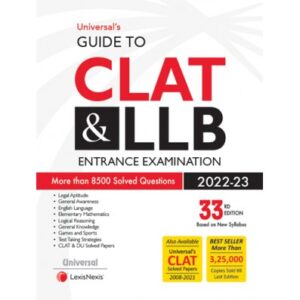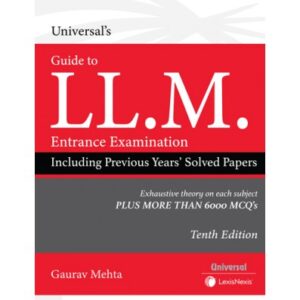Civil Procedure Code by C.K. Takwani provides an interesting and lucid study of the fundamental principles of civil procedure in a logical sequence. The topic-wise treatment of the subject along with references to academic writings and judicial decisions makes the study of civil procedure more meaningful and comprehensible. This book explains complex legal concepts with clarity and coherence as well as covers all aspects and dimensions of law relating to Civil Procedure and Limitations in India. The current ninth edition of the book has been thoroughly revised and updated by the author.
Salient Features:
1. Incorporates all legislative developments including a new chapter on Commercial Courts Act, 2015.
2. Rulings on the subject by the Supreme Court, as well as the High Courts, have been painstakingly extracted by the author and all the latest case law up to (2020) 16 SCC have been incorporated.
3. Certain topics such as res sub-judice, res judicata, set-off and counterclaim, ex-parte decree, affidavits, interim orders, consent decree, examination of witnesses, suits by or against the government, letters patent appeal, transfer of cases, etc. have been discussed in detail.
4. Discusses the leading decision in M. Siddiq v. Suresh Das (popularly known as the Ram Janmabhoomi case) as reported in (2020)4 SCC 1.
5. Includes List of Suggested Readings, which is a compilation of articles by legal luminaries to widen the scope of discussion on several topics.
6. Legal maxims or principles explaining the topics discussed, have been quoted at the beginning of every chapter.
7. The topic-wise treatment of the subject along with references to academic writings and judicial decisions makes the study of civil procedure more meaningful and comprehensible.
Additional learning resources through www.ebcexplorer.com:
- Important case law indicated by Case PilotTM.
- Useful LinksTM feature to get access to a compilation of free resources.
- Discussion ForumTM to post comments, discuss issues and explore ideas.
- SCC Online BlogTM to stay updated on recent development in this area.
This is a compact, intelligent, plainly written, and well-organized account of the law relating to Civil Procedure in India. Overall this book is an enormous wealth of information in a compact, easily understandable form. One of the interesting things about the book which sets it apart is the case laws and the case references and the lucid language to understand the complexities of Civil Procedure. This book, prescribed in almost all universities in India, though written for students and junior members of the Bar, is a great reference tool for lawyers and judges.
Review
The clarity of thought and lucidity in style differentiate a masterly author from a compiler of monotonous facts. Among the multitude of Indian law books whose hallmark is lack of originality and clarity, the present work stands apart for its lucidity, clarity and novelty.
-The Academy Law Review
About the author
Chunilal Karsandas Thakker (born 10 November 1943) is a retired judge of the Supreme Court of India. Justice Thakker was born at Mander near Porbandar in the State of Gujarat.
Thakker was appointed as part-time Lecturer in Law in Sir L.A. Shah Law College, Ahmedabad, in 1970 and continued as such until he was elevated to Judge of the High Court of Gujarat on 21 June 1990. He was also Acting Governor of the State of Maharashtra from July to October 2002. Thakker was appointed as a judge of the Supreme Court of India on 7 June 2004
He has written books “Lectures on Administrative Law“, “Civil Procedure” and “Criminal Procedure” which have been appreciated in India as well as in U.S.A. Also revised V. G. Ramchandran’s monumental work “Law of Writs” (1993) and Ratanlal & Dhirajlal’s “Law of Crimes” (2002) (Silver Jubilee Edition).
PART 1 – Preliminary
1. Introduction
2. Definitions
PART 2 – Suits
1. Jurisdiction of Civil Courts
2. Res Sub Judice and Res Judicata
3. Foreign Judgment
4. Place of Suing
5. Institutions of Suit
6. Pleadings
7. Plaint and Written Statement
8. Appearance and Non-appearance of Parties
9. First Hearing
10. Discovery, Inspection and Production of Documents
11. Interim Orders
12. Withdrawal and Compromise of Suits
13. Death, Marriage and Insolvency of Parties
14. Trial
15. Judgment and Decree
16. Special Suits
PART 3 – Appeals, Reference, Review and Revision
1. General
2. First Appeals
3. Second Appeals
4. Appeals from Orders
5. Appeals by Indigent Persons
6. Appeals to Supreme Court
7. Reference
8. Review
9. Revision
PART 4 – Execution
1. Execution in General
2. Courts Which May Execute Decrees
3. Application for Execution
4. Stay of Execution
5. Mode of Execution
6. Arrest and Detention
7. Attachment of Property
8. Questions to be Determined by Executing Court
9. Adjudication of Claims
10. Sale of Property
11. Delivery of Property
12. Distribution of Assets
PART 5 – Miscellaneous
1. Transfer of Cases
2. Restitution
3. Caveat
4. Inherent Powers of Courts
5. Delay in Civil Litigation
PART 6 – Limitation Act
1. Limitation Act, 1963
PART 7 – Commercial Courts
APPENDICES
1. Plaint
2. Written Statement
3. Issues
4. First Appeal
5. Second Appeal
6. Revision
7. Injunction Application
8. Affidavit
9. Caveat





Reviews
There are no reviews yet.